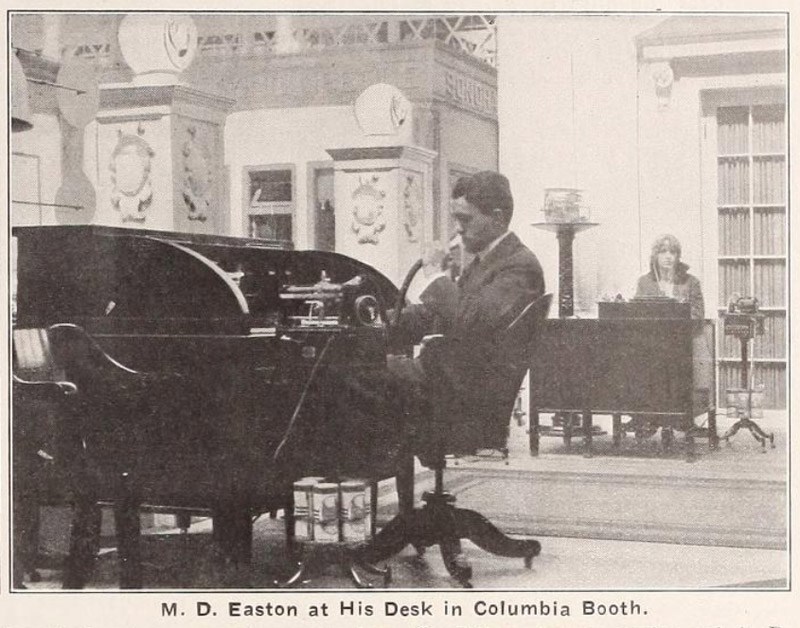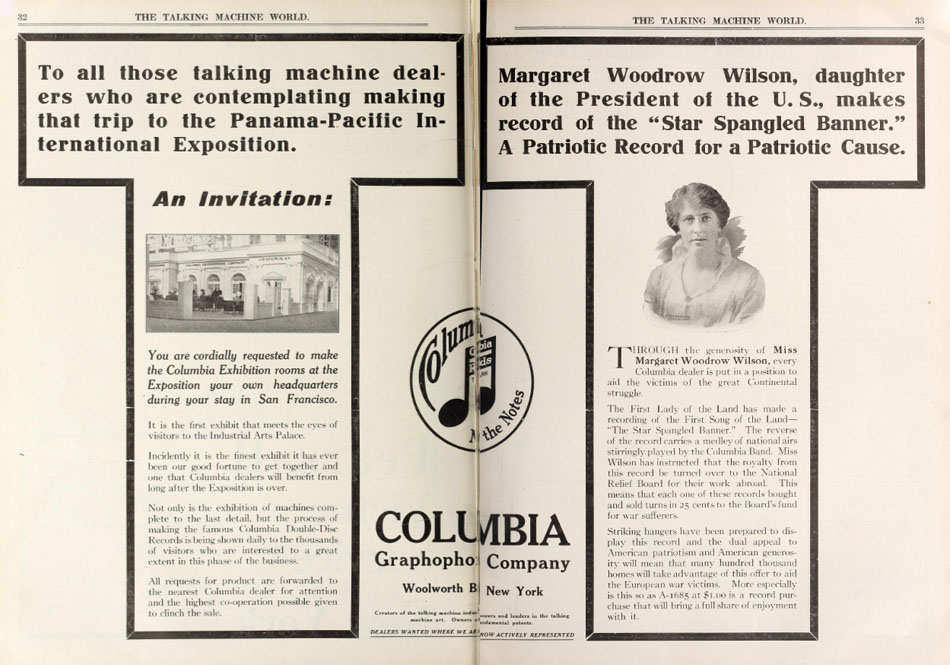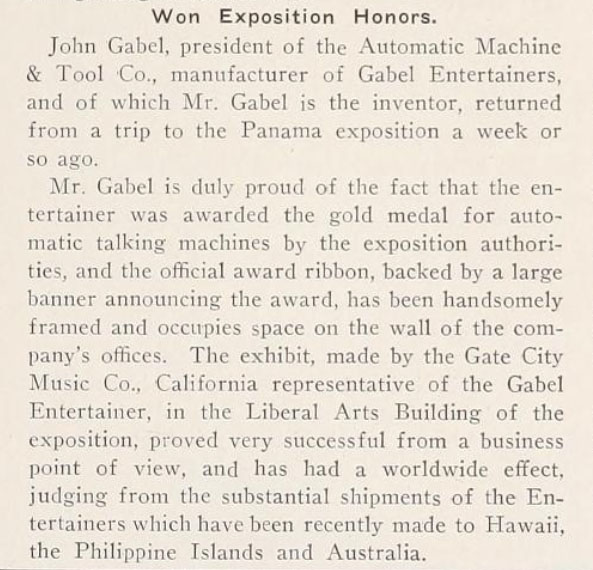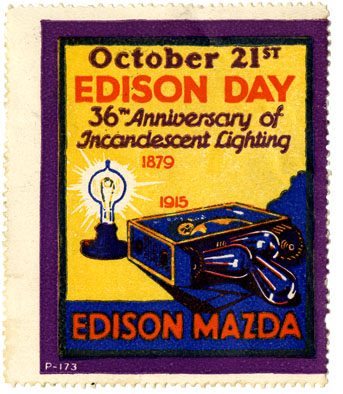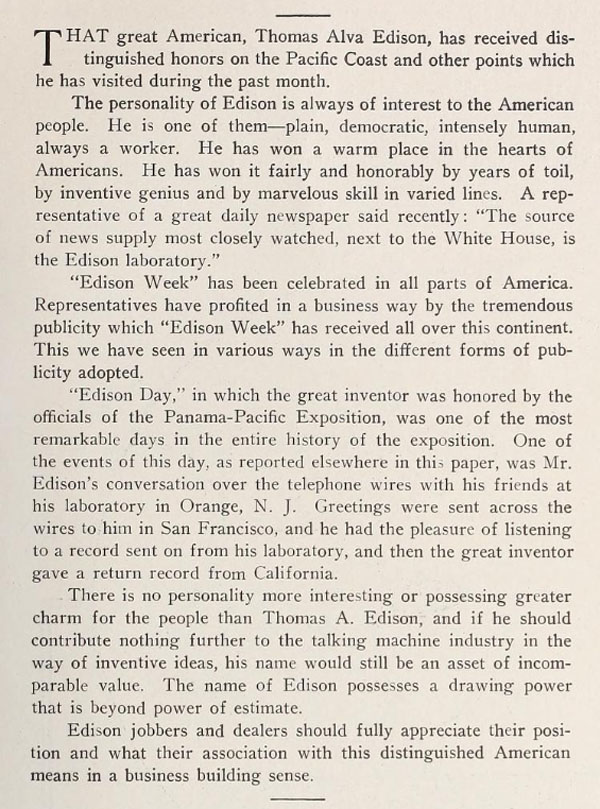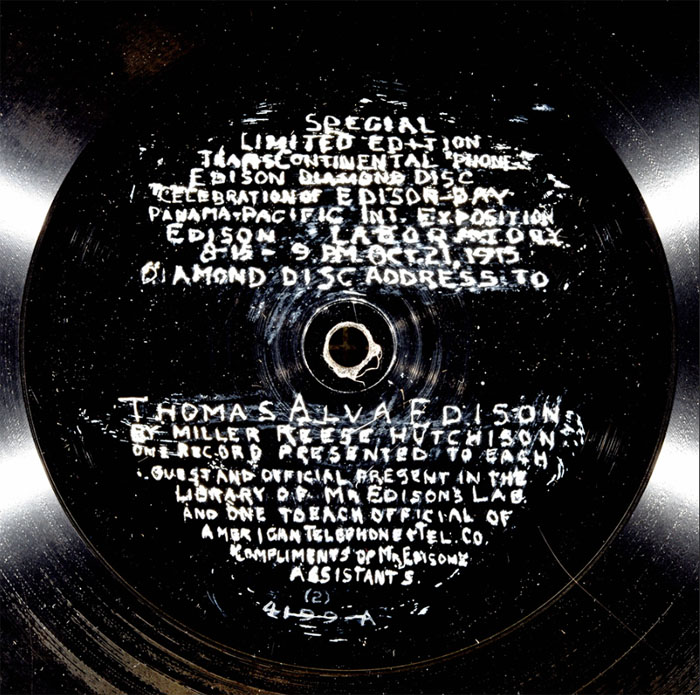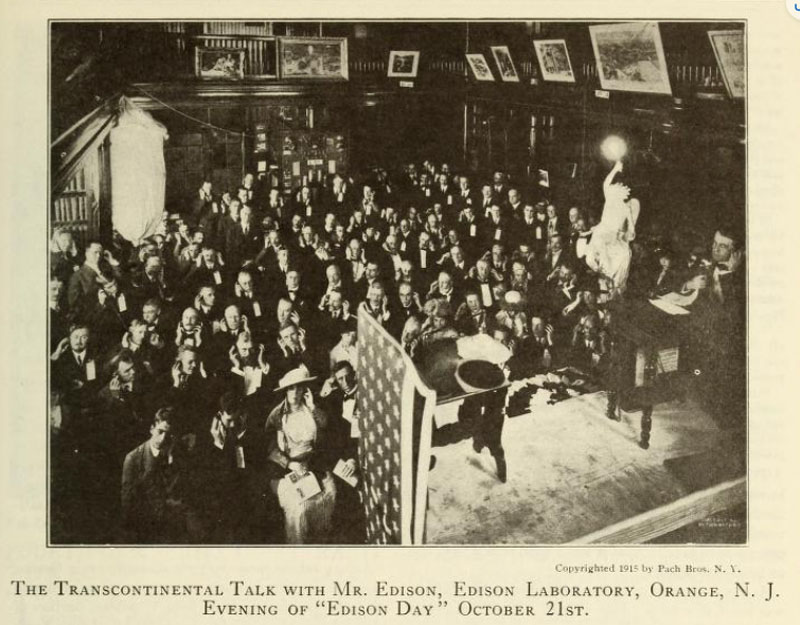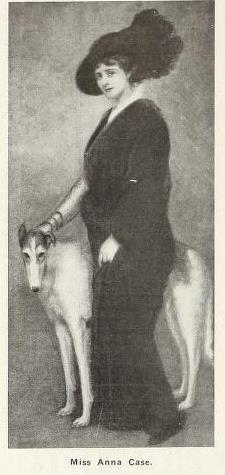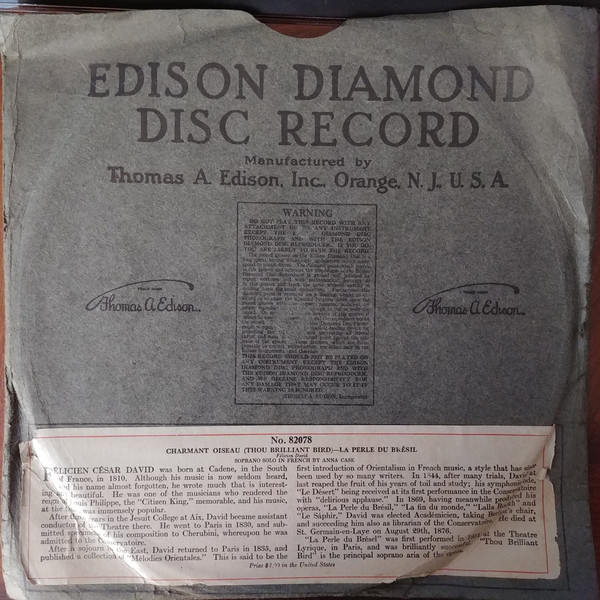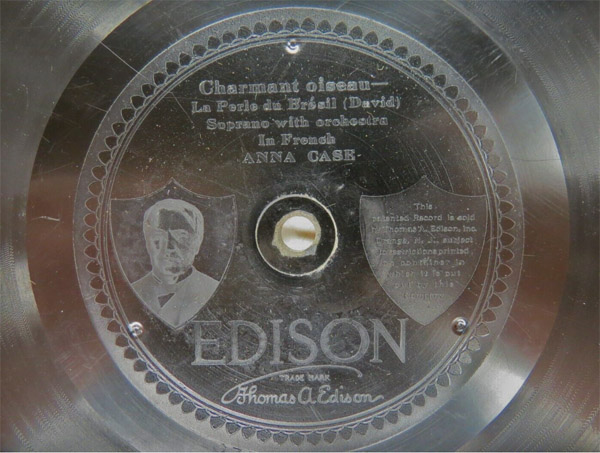The Victor Talking Machine Co.,
"The Handsome Victor Temple."
"The Victor Temple, as the exhibit
of the Victor Talking Machine Co. is officially known, is artistically
built and beautifully furnished, and from the advantageous location
under the dome in the center of the building has already proved itself
a center of interest. The temple is of old Roman Doric architecture
and includes a drawing room with miniature stage, reception room,
office and rest rooms, also a record room supplied with 7,000 records,
domestic and foreign, which will be used in daily concerts...Two beautiful
Victrolas, hand-painted on a dull-gold finish, are placed on the stage,
and many other handsome instruments are included in the display."
The Talking Machine World, March 15, 1915, p. 19.
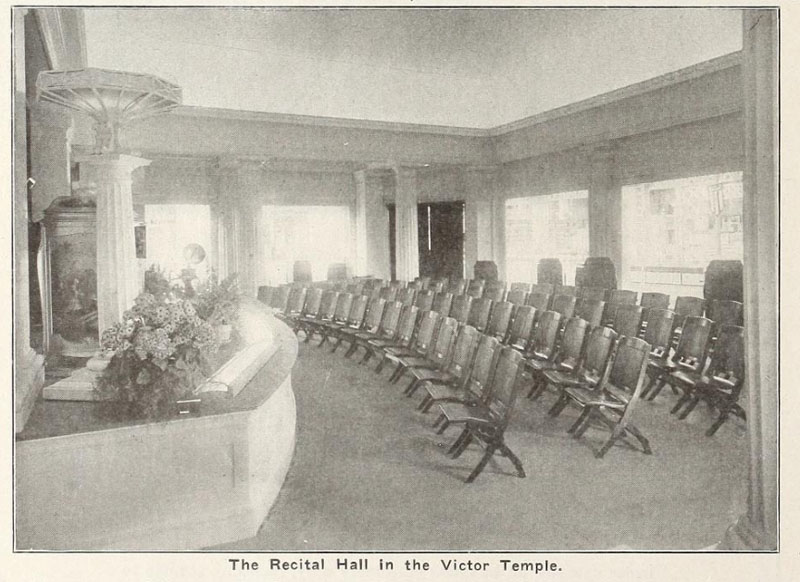
The Talking Machine
World, March 15, 1915
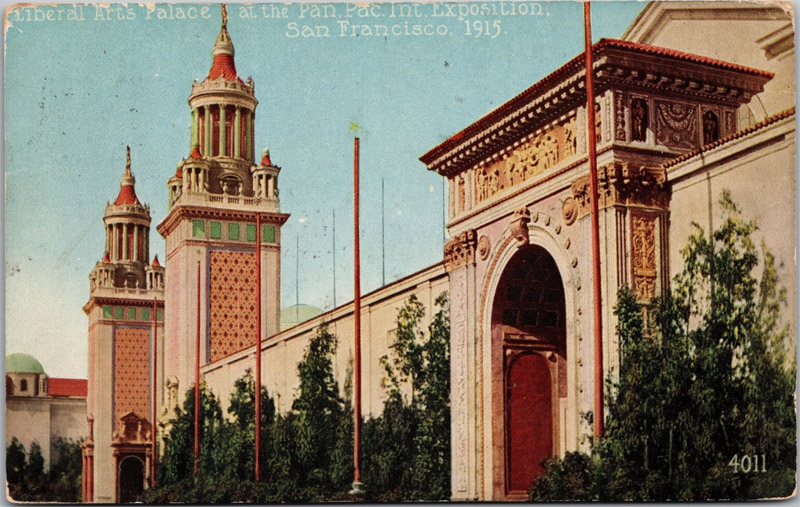
Liberal Arts Palace where
inside Victor's Temple of Music was located, postcard, 1915.

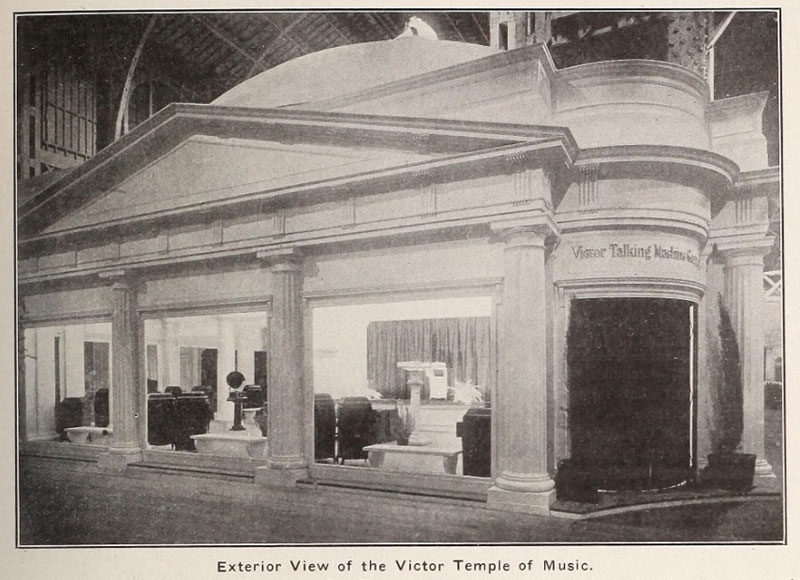
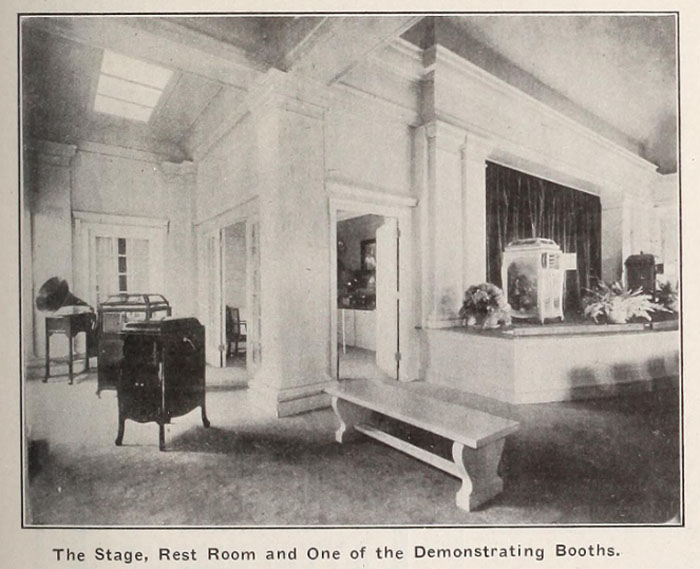
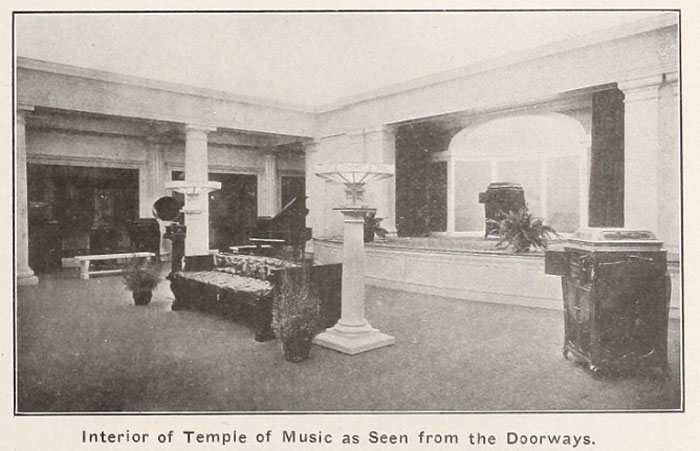
The Talking Machine
World, April
15, 1915.
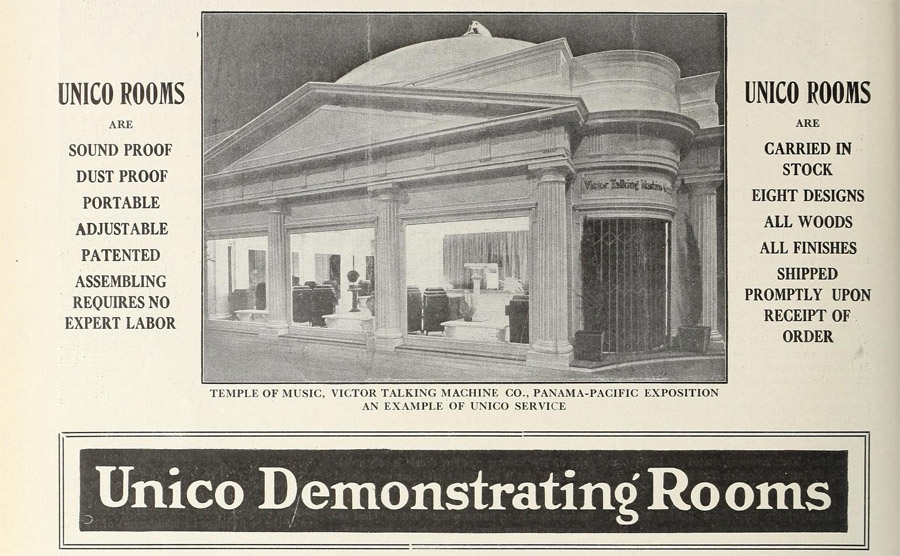
Unico ad for Victor's Temple
Music as an example of Unico Service, The
Talking Machine World, July 15, 1915.
Record listening booths
for baby boomers were still common in record and department
stores, however, CDs and iPods and Spotify have since removed that
'experience' for the new music listening generations. High-end listening
rooms for sound systems are probably the best remaining examples of
that sound shopping experience. See Phonographia's Record
Listening Booths for more examples from the era that introduced
the phonograph and its record demonstration rooms. See Shopping
for a Phonograph for early advertising examples of encouraging
consumers to visit a phonograph dealer and listen for themselves.
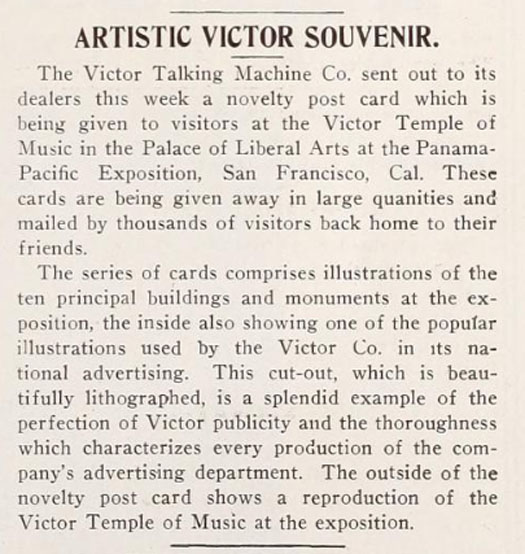
The Talking Machine
World, July 15, 1915.
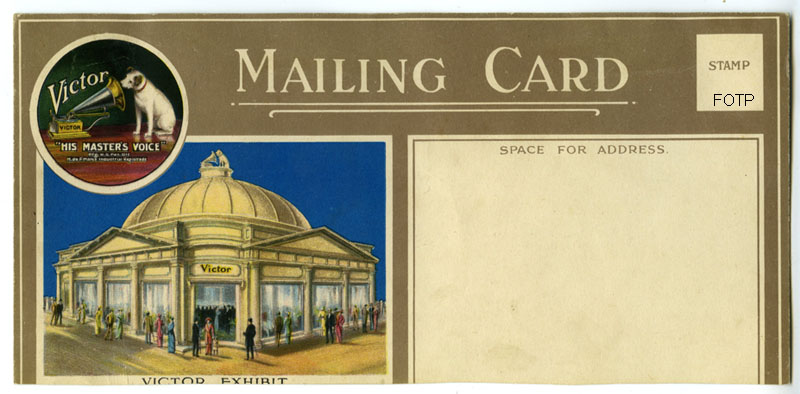
Victor Souvenir Post
Card with Victor Temple of Music (PM-0298).
Sonora Phonograph Co.'s "Excellent
Exhibit."
"The Sonora Phonograph Co.,
of this city, occupied the booth across Fourth street from the Columbia
exhibit, with a comprehensive showing of Sonora phonographs. This
booth...is well equipped for demonstration purposes, there being
large open space for a general display, besides sound-proof rooms.
The decorations of the booth are carried out effectively in old
rose and a blue gray, while a touch of gold is given by gilt bells,
which form a prominent feature of the decoration. These bear the
words "Clear as a Bell," the trade-mark of Sonora products.
A large bell stands in the center of the terrace, and a number of
small ones surmount the balustrade at regular intervals."
(Ibid. p. 19).
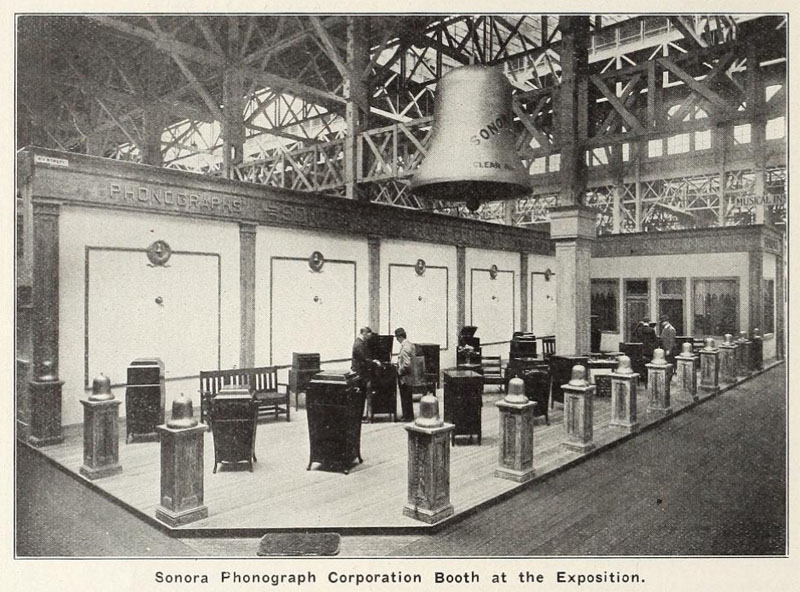
The Talking Machine
World, April 15, 1915.

The Talking Machine
World, July 15, 1915.
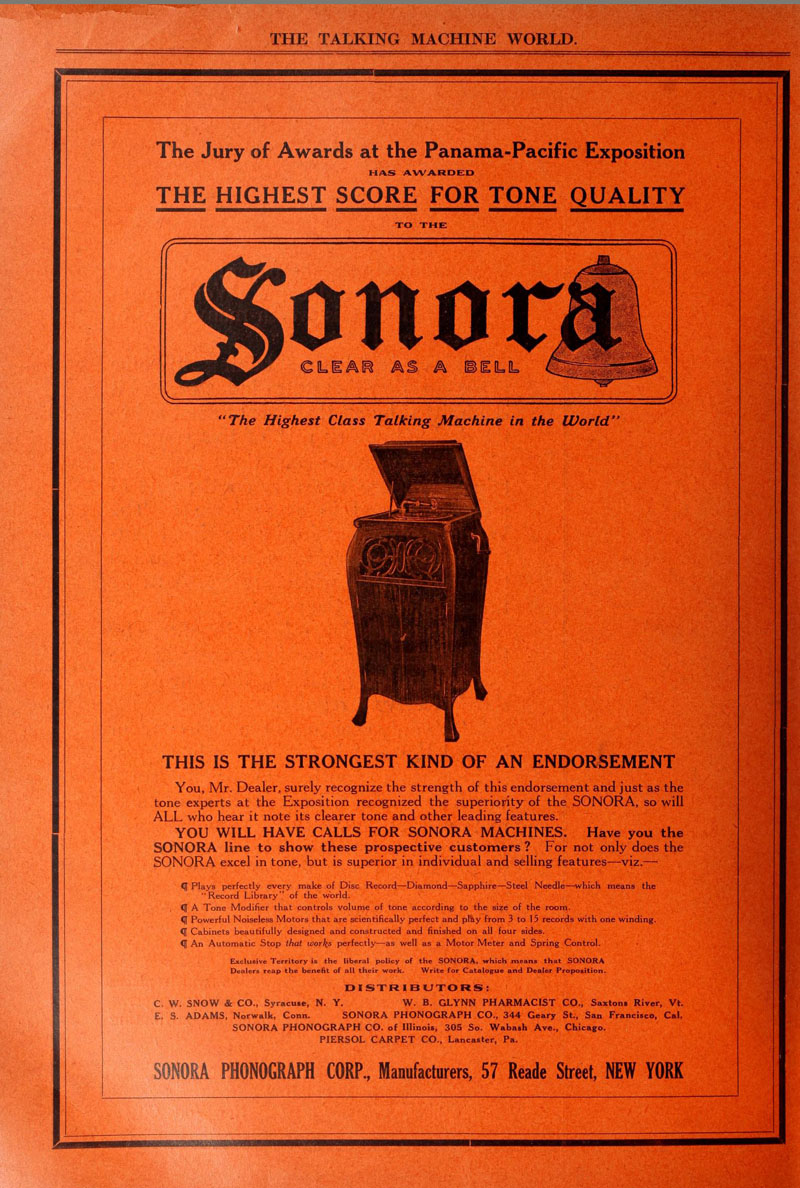
The Talking Machine
World, September 15, 1915.
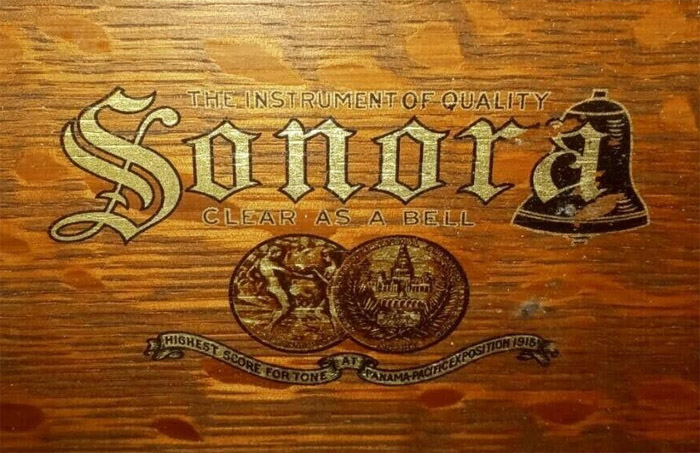
After Sonora's 1915 "Award"
at the Panama-Pacific Exposition the logo inside their phonograph
lids was updated.
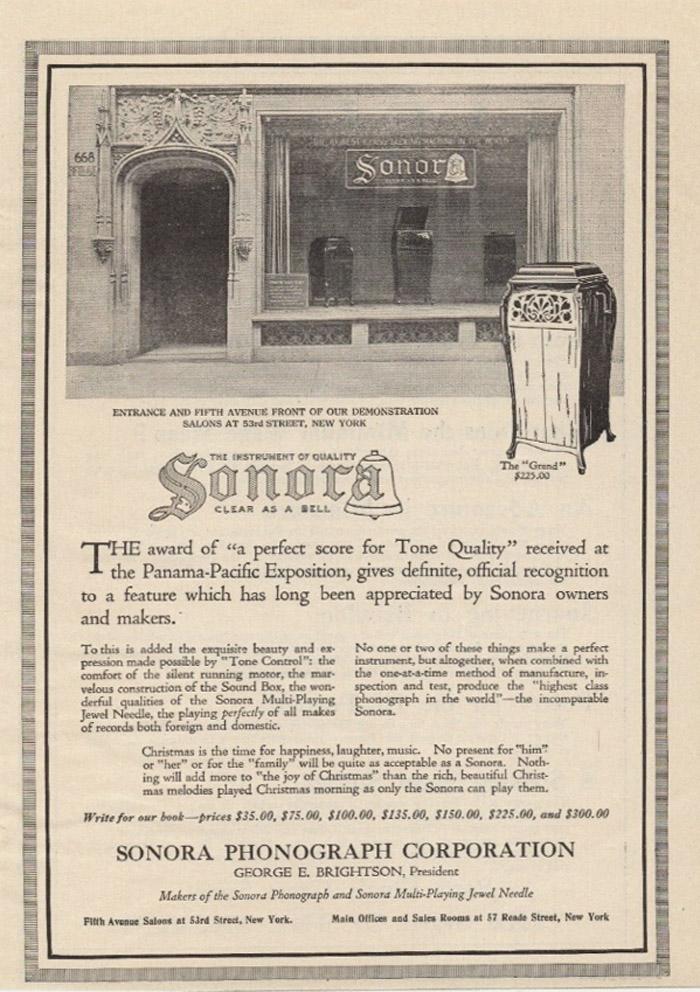
According to this and other
advertisements Sonora had received an award for "perfect score
for Tone Quality" at PPIE, magazine ad (5.75" x 8.25"),
1915. What a "perfect score" meant is unclear and awards
like this for Edison were now seemingly irrelevant. Instead, Edison's
ads would make the case that Christine Miller's Edison Day performance
at the PPIE where she sang with Edison's Diamond Disc re-creation
of her own voice and no one could tell the difference was indisputable
evidence that "Edison's new invention is in a class by
itself."
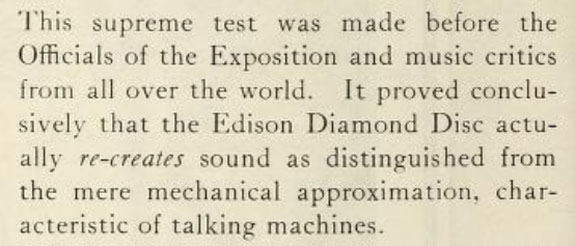
The Edison Phonograph
Monthly, November 1915
For examples of Sonora's
phonograph advertisements after 1915 see Phonographia's Sonora
- "Clear as a Bell."
Cheney Talking Machine Co.'s Exhibit.
"A space 30 by 60 feet between
the Victor and Columbia displays has been taken by the Cheney Talking
Machine Co., which is making its advent in the Pacific Coast territory.
This booth is entirely enclosed. Half of the space is being utilized
for a concert hall and the remainder for office, rest room, record
room etc." (Ibid. p. 19).


The Talking Machine
World, April 15, 1915.
Thomas Edison and Henry Ford at Western
Union exhibit in the Liberal Arts Palace. Cardinell-Vincent Company,
Photographer. 1915. Courtesy of the University of California, Davis.
(6)
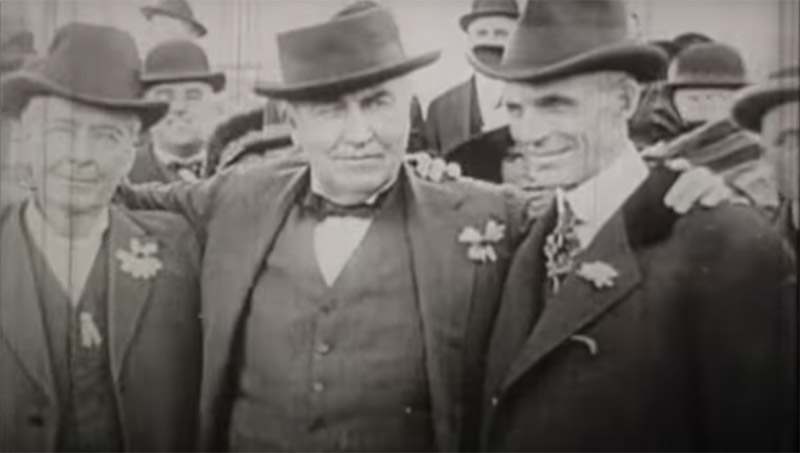
Luther Burbank, Thomas Edison, and
Henry Ford at the Palace of Machinery (Source: Screenshot from PPIE
film - Julius S. Rodman Associates, Documentary Film Division, Tiburon,
CA, KPIX TV)
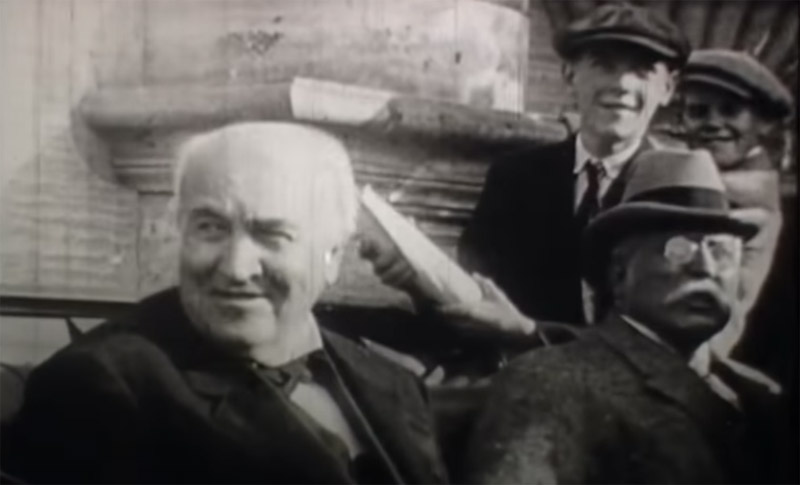
Thomas Edison and Teddy
Roosevelt in automobile at the fair. (Source: Ibid).
Christine Miller at the Exposition
Another event on "Edison Day"
which promoted the Edison Diamond Disc Phonograph was Christine Miller's
performance at the PPIE where she sang with Edison's Diamond Disc
re-creation of her own voice to demonstrate that Edison had achieved
his ambition actually to re-create music so perfectly that the re-creation
cannot be distinguished from the original."
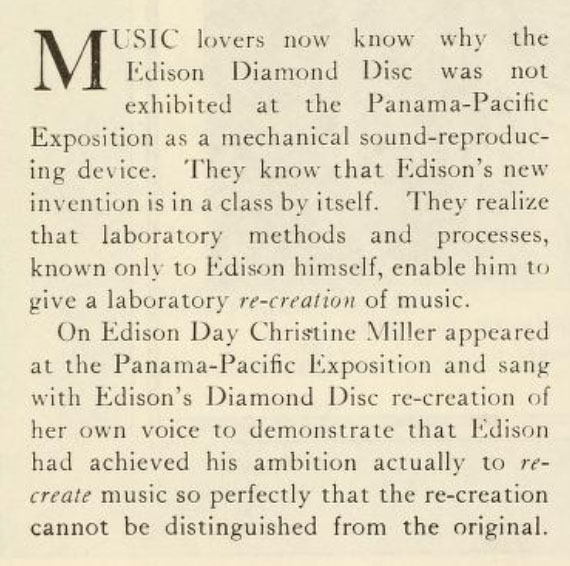

The Edison Phonograph
Monthly, November 1915.
The Boston Sunday Herald reported
the following details about Christine Miller's Tone-Test performed
on October 21, 1915 in their November 21, 1915 edition:
"The first tone-test
was given at the Panama Pacific exposition on October 21, Edison
Day, as it was called....On that day Miss Christine Miller consented
to prove to Mr. Edison just what perfection he had attained in reproducing
the human voice. Before a vast crowd of visitors from all corners
of the globe Miss Miller sang her first duet with herself. So astounding
was the initial performance, so identical was her voice with its
laboratory reproduction, that even Edison admitted that he had invented
something far beyond his ambition." (5)
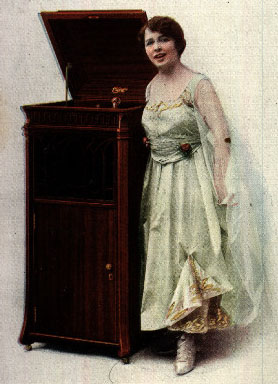
Christine Miller
Miller and other Edison
tone-test artists would be heavily promoted during the next decade
as they travelled and performed
in listening rooms, rented halls, and auditoriums throughout the country.
Countless newspaper ads highlighted the popularity of these comparison
tests and the difficulty listeners had in telling the difference between
the 'live' and the recorded sounds.
"Not one could distinguish
the living and breathing Christine Miller's voice from Edison's
laboratory Re-Creation of that self same voice...May we
prove it to you?"
By 1920 Edison's tone-tests
had been performed more than four-thousand times. They would continue
until 1925.
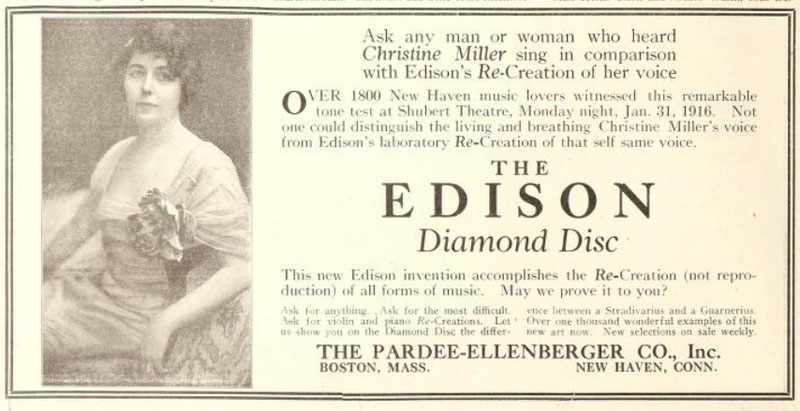
"The Edison
Diamond Disc: The Re-Creation (not reproduction) of
all forms of music." The Talking Machine World, February
1916.
For more on Edison's Re-Creation
of voices and Edison's tone-tests visit Phonographia's gallery Edison
Tone Tests.
For more details about
"Edison Day," see "On
this Day - October 21 - Edison Day " by PPIE-100.
The "Panama
Canal" Exhibit
The Panama Canal Zone was near the Fillmore
Street entrance of the fair and was almost five acres in size. It
was advertised as the "largest reproduction of any subject ever
created." This working diorama of the Panama Canal used a moving
platform where its visitors sat and could look down at the miniaturized
Canal Zone. A system combining telephones and sixty Edison Phonographs
and respective Blue Amberol
records synchronized with the visitor's changing views of the
diorama 20 feet below provided the audio for the unique guided tour.
The following is an excerpt from Allen
Koenigsberg's article “Step
Right Up! Edison’s
Blue Amberol Tour of the Panama Canal,"
(Koenigsberg, Allen, "The Sound Box," December 2007).
"On the moving platforms,
there are 1200 opera chairs, each equipped with a duplex telephone
receiver; that is, a receiver for each car attached to an adjustable
handle so that the spectator can hold it to his ears without placing
his arms in an unnatural or uncomfortable position. Through these
receivers, the spectators get a continual (and gradually updated)
lecture as the trip is made around the ‘miniaturized’ Canal Zone.
The system by which this lecture is delivered was invented and perfected
especially for this purpose and consists of a novel combination
of phonograph and telephones. This in itself marks a new era in
sound reproduction. Sixty phonographs, located in a nearby room
deliver the lecture into telephone transmitters, which in turn transmit
it (in segments) through a series of wires, rails, and various devices
to the telephone receivers attached to the seats on the platform,
as each makes its circuit." (Koenigsberg, Ibid. p. 5.)

"THE PANAMA CANAL"
and "SCENES ON THE PANAMA CANAL" show the main building
and some features of the diorama of the Panama Canal as seen in "The
Blue Book, A Comprehensive Official Souvenir View Book Illustrating
the Panama-Pacific International Exposition at San Francisco 1915",
Robert A. Reid, View Books, San Francisco, 1915 , p. 308.

Scenes on the Panama
Canal. (Ibid. p. 309).
"Official Opening
of the Panama-Pacific International Exposition, San Francisco, 1915"
is a film of the Panama-Pacific International Exposition made by the
Exposition Players Company. Footage includes visitors going into the
Panama Canal exhibit, taking their seats and then viewing the diorama
scenes and the mechanically operated features of the Canal Zone. (Footage
starts at 41:36). (Source material provided by Bancroft Library. Preserved
and made available online by California
Revealed.)
A 1932 Version of the 16mm
film was later released titled "Phantom City: A Retrospect of
the Panama-Pacific International Exposition of 1915" by Long
(S.C.) Productions. (Source: the Frank
Vail Collection.)
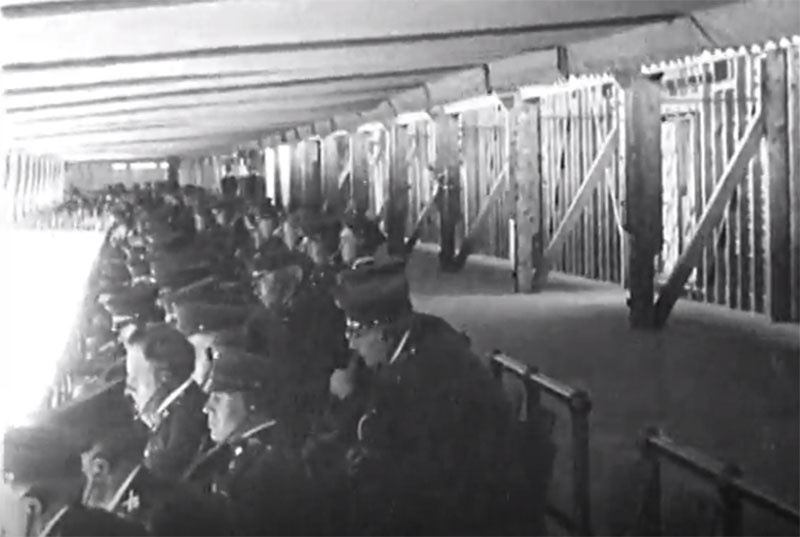
Seated visitors viewing
the 'Panama Canal Zone" from their moving chairs with a receiver
attached to an adjustable handle so that the spectator can hold it
to his ears without placing his arms in an unnatural or uncomfortable
position." (Koenigsberg, ibid. p. 5.) (Above screenshot from
1932 film at 7:45.)
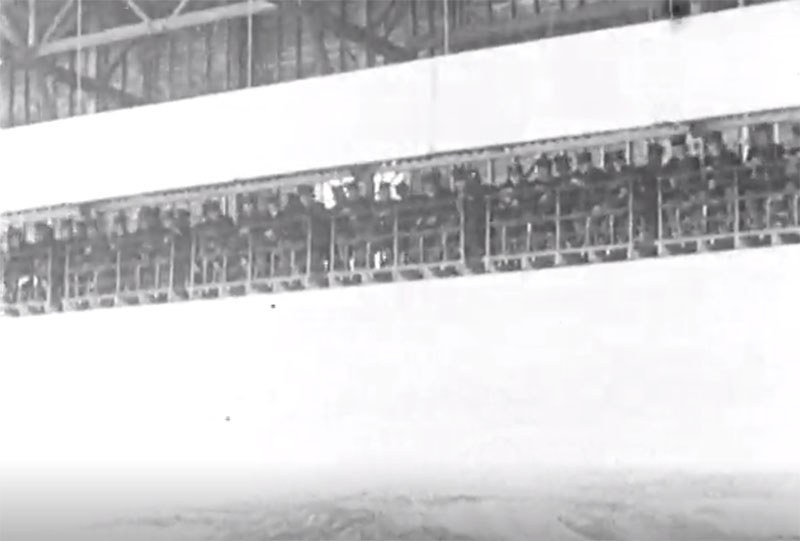
Visitors observing from
20 feet above the Panama Canal Zone diorama. (Screenshot at 7:50 of
film.)
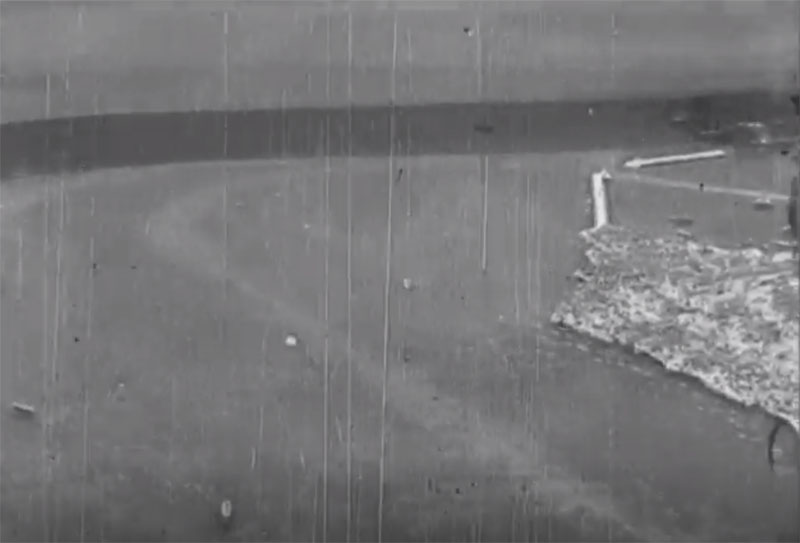
Still from the1915 film
looking down at the canal entrance. (Screenshot at 42:35 of film.)
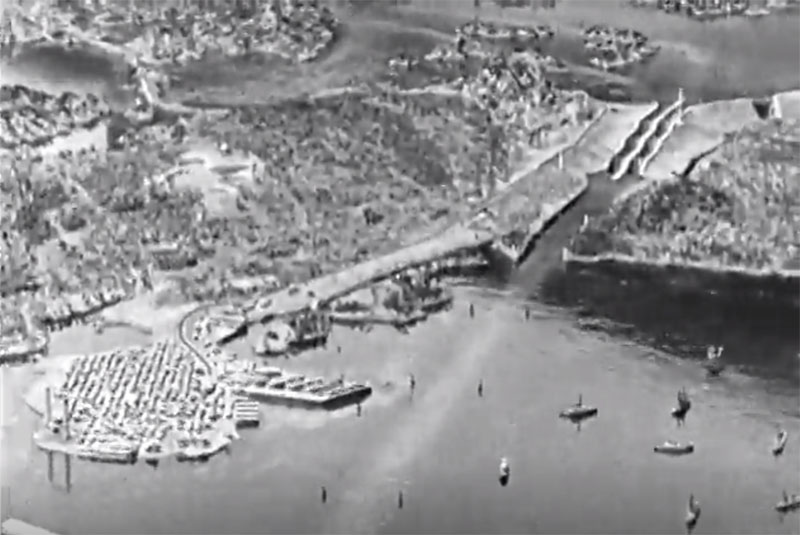
Another view for the
spectators as seen in the 1932 movie. (Screenshot at 7:41 of film.)
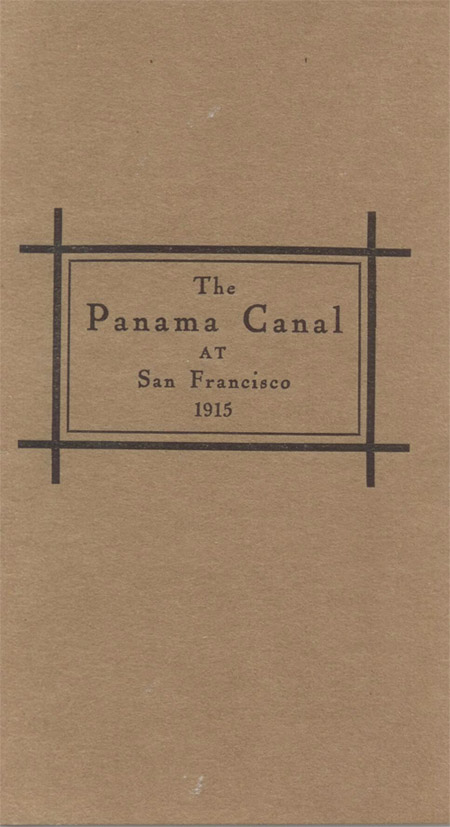
Cover for "The Panama Canal at
San Francisco 1915" booklet published by Panama Canal Exhibition
Co. (Source: "The Last Great World's Fair." JB-TPC
Booklets/Brochures
from The Jamieson Collection.)
The
Edison Blue Amberol Records for the Panama Canal Tour
The Edison Records used
at the Panama Canal Concession played, on average, 3300 times per
week and were said to have been replaced on an average of every six
weeks. Edison's trade magazine The Edison Phonograph Monthly
reminded its dealers that this durability of Blue Amerbols should
be a strong selling point.


The Edison Phonograph
Monthly, June 1915.
Blue Amberol Record
for Panama Canal Zone G, No. 20, 21 and 22
See “Step
Right Up! Edison’s
Blue Amberol Tour of the Panama Canal,"
(Koenigsberg, Allen, "The Sound Box," December 2007, p.
7) for a photograph of the rim of "one of 15 such cylinders"
used for the "23 minute circuit" tour and a transcription
of the Panama Exhibit Co.'s telephone-phonographic 'lecture"
on a Blue Amberol Record for Zone G, No. 20, 21 and 22 (Field
Markers) of the tour -- The Operation of the Panama Canal, as explained
by Harry Humphrey on a ‘2-Minute-style’ Edison Blue Amberol Cylinder.

Transcription of Two-Minute-Style
"Panama Canal Zone G" Blue Amberol Cylinder, The
Antique Phonograph Monthly, May 1987, p., 6 (the original
article where the retelling of this story began, courtesy Allen
Koenigsberg).
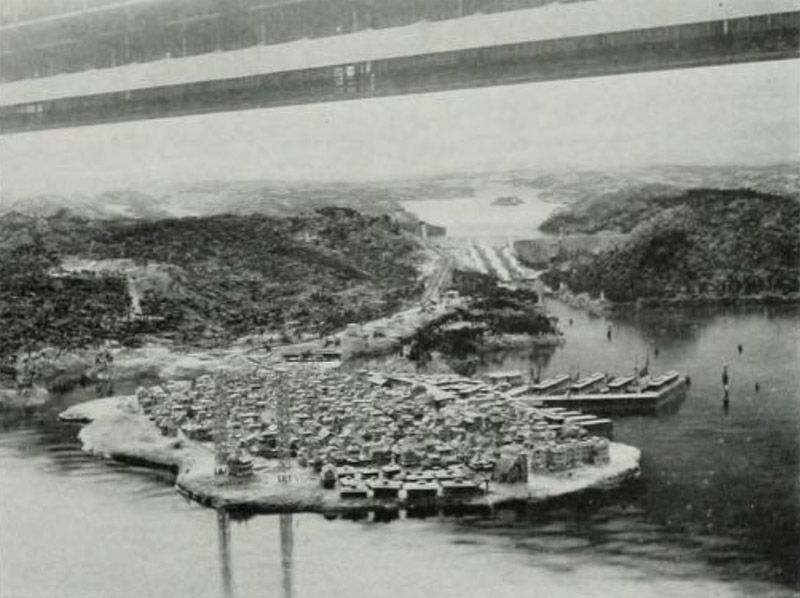
Zone G Mark No. 20:
The City of Colon, looking toward Gatun Locks and Limon Bay. ("The
Blue Book," Ibid. p. 309.)
Blue Amberol Record
for Panama Canal Zone D, No. 5, 6, 7, 8, and 9
The Operation of the
Panama Canal, as explained by Harry Humphrey for Zone D,
No. 5, 6, 7, 8, and 9 (Field Markers) on a '2-Minute-style' Edison
Blue Amberol Cylinder.
LISTEN
to The Operation of the Panama Canal Zone D, as explained
by Harry Humphrey. [Download
option to Listen] - (Record courtesy of Rod Pickett.)
The following is its transcription
with the diorama's tour position Mark Numbers noted by narrator.
"Zone D. Number 4 Mark Miraflores
Lock. Here vessels are lifted 55 feet in two stages, from sea level
to the level of Miraflores Lake shown at 5. Crossing this lake,
a distance of a mile and a half, the vessels come to Number 6, the
Pedro Miguel Lock, where they are lifted 30 feet to the famous Culebra
Cut, the level there being 85 feet above sea level the highest level
reached by a vessel in crossing the Isthmus.
Number 7 marks the center of the
Culebra Cut, which during the construction period was the most famous
and interesting part of the canal. It is nine miles long and has
an average depth of 120 feet; and at Gold Hill, Number 8, a maximum
average depth of 375 feet, more than 100 million cubic yards of
material was removed from this cut, approximately half the excavation
of the entire canal.
Enormous slides developed along
the banks of this cut and one of the largest, the Cucaracha Slide,
is shown at 9. More about
this great cut later."
Zone D Mark Number 4
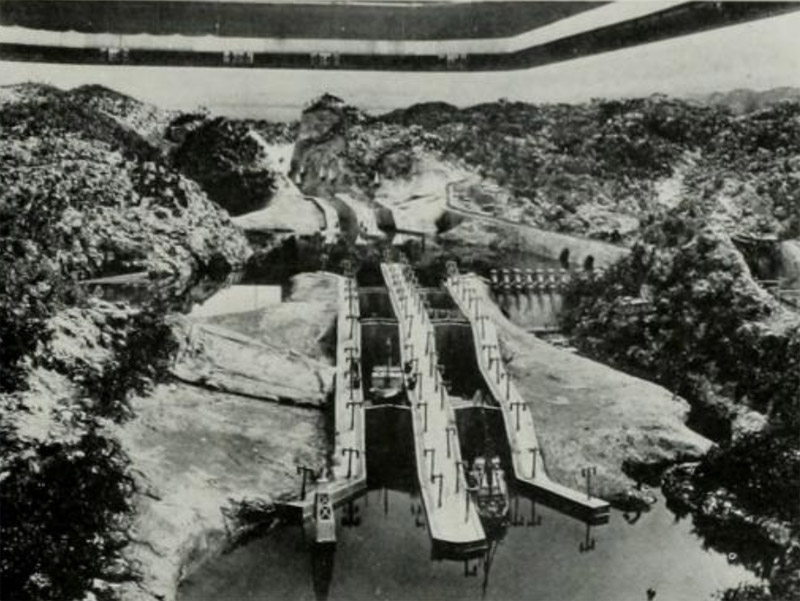
Zone D Mark Number 4: "The Miraflores
and Pedro Miguel Locks, "Scenes on the Panama Canal, ("The
Blue Book," ibid. p. 309).
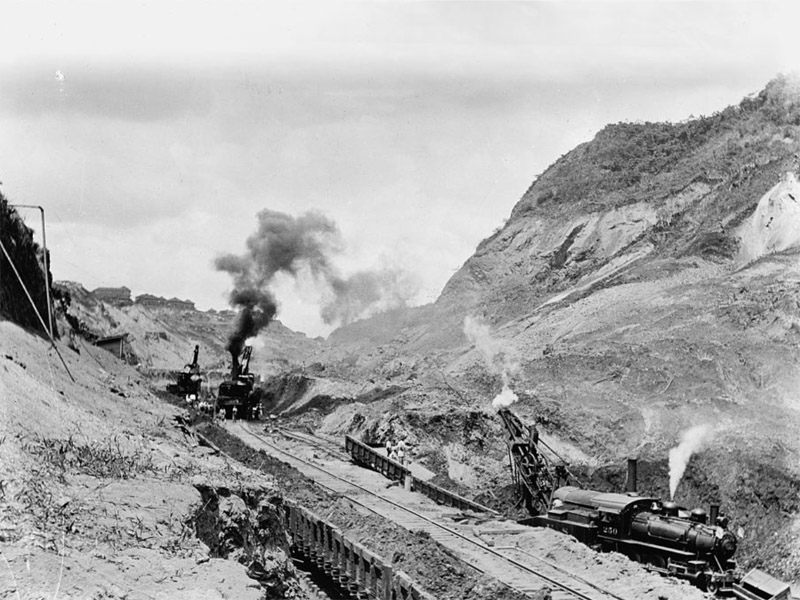
Construction at the Cucaracha
slide, Panama Canal (between 1910 and 1914) (Source: Library of Congress).
Detroit Publishing Co.,
Copyright Claimant, and Publisher Detroit Publishing Co. Famous Cucaracha
slide, Panama Canal. Panama Panama Canal, None. [between 1910 and
1914] Photograph. https://www.loc.gov/item/2016814015/.
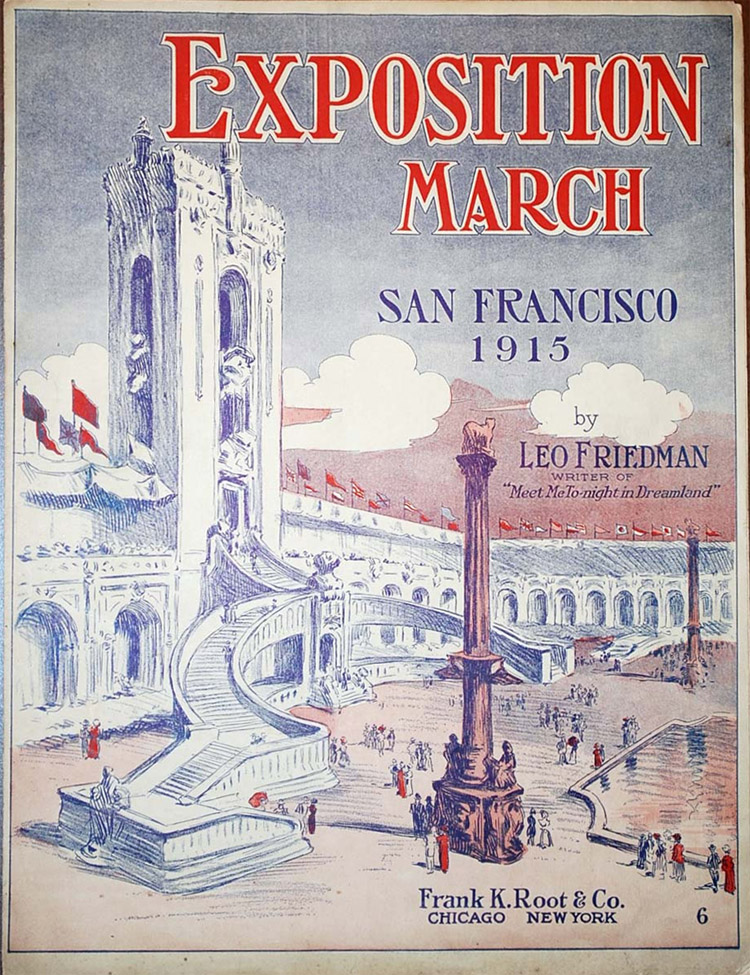
"Exposition March
San Francisco 1915" by Leo Friedman, Frank K.Root & Co.,
Chicago New York 1915 (Courtesy Jamieson Collection, JC-SEM).
LISTEN
to "Panama Exposition March"
(Chas. A. Prince) Played by Prince's Band, Columbia 10" Record
No. A1195 (Courtesy David Giovannoni Collection and i78s.org).
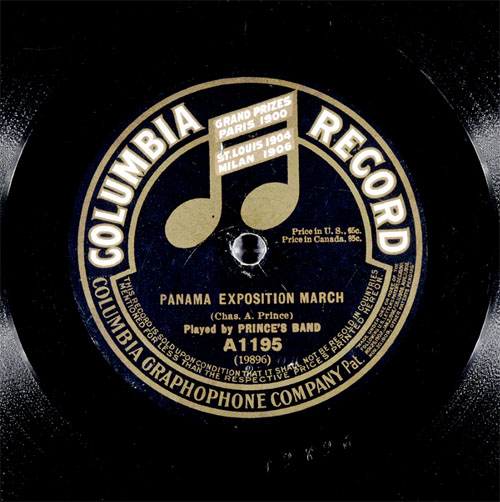
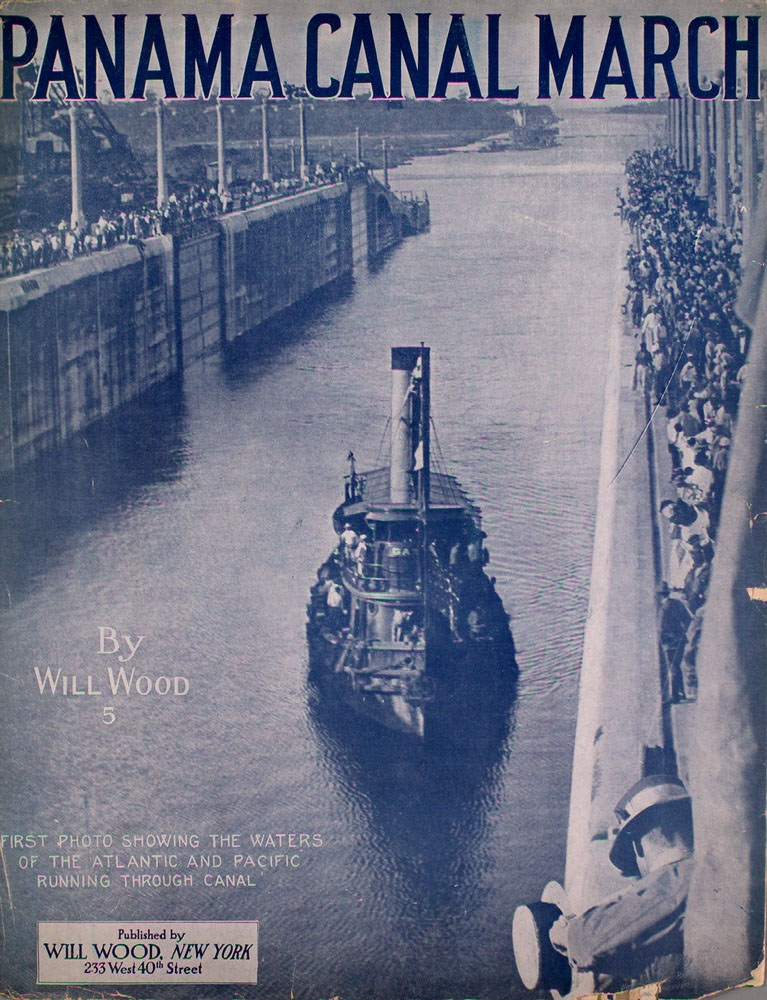
"Panama Canal March," by Will
Wood. Published by Will Wood, New York, 1913 (Source: Lester
S. Levy Sheet Music Collection, Johns Hopkins).
LISTEN
to "Through the Panama Canal" (Von der Mehden) Descriptive
played by Prince's Band, Columbia 10" Record No. A1528 (Courtesy
David Giovannoni Collection and i78s.org).
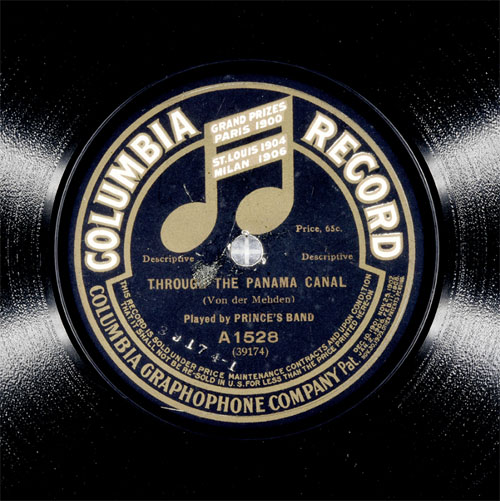
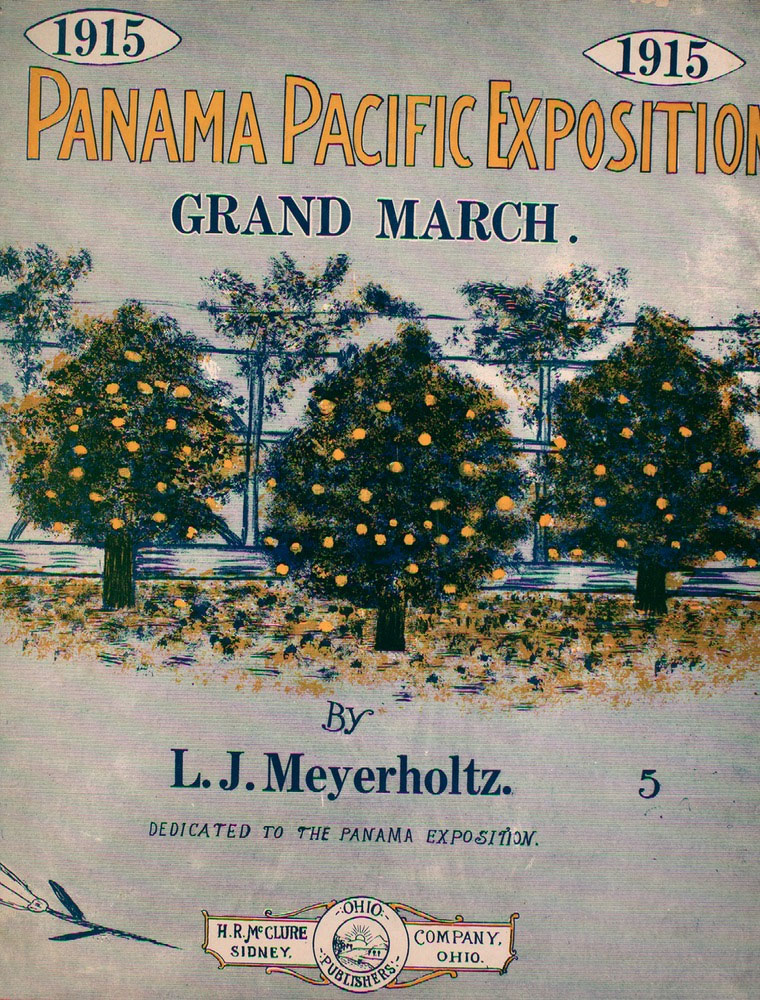
"Panama Pacific Exposition Grand
March" by L.J. Meyerholtz. "Dedicated to the Panama Exposition."
Published by H.R. McClure Company, Sidney, Ohio, 1912 (Source:
Lester
S. Levy Sheet Music Collection, Johns Hopkins).

"In San Francisco the Fair Will
Be Best," Words by Sam Harrison. Music by A.J. Bloom. Publisher
Southwest Music Publishing Co., 851 Washington St., Oakland, CA,
1910 (Source: Lester
S. Levy Sheet Music Collection, Johns Hopkins).
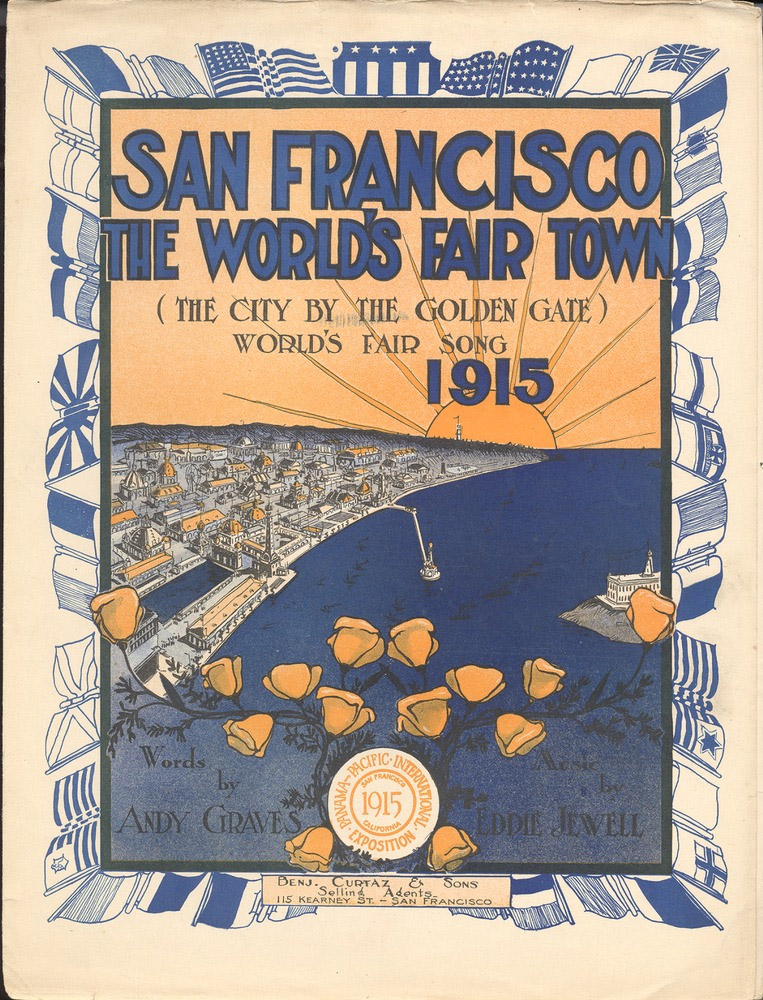
"San Francisco The World's Fair
Town," Words by Andy Graves. Music by Eddie Jewell. Publisher
Benj. Curtaz & Sons, 115 Kearney St., San Francisco, 1912 (Source:
Lester
S. Levy Sheet Music Collection, Johns Hopkins).
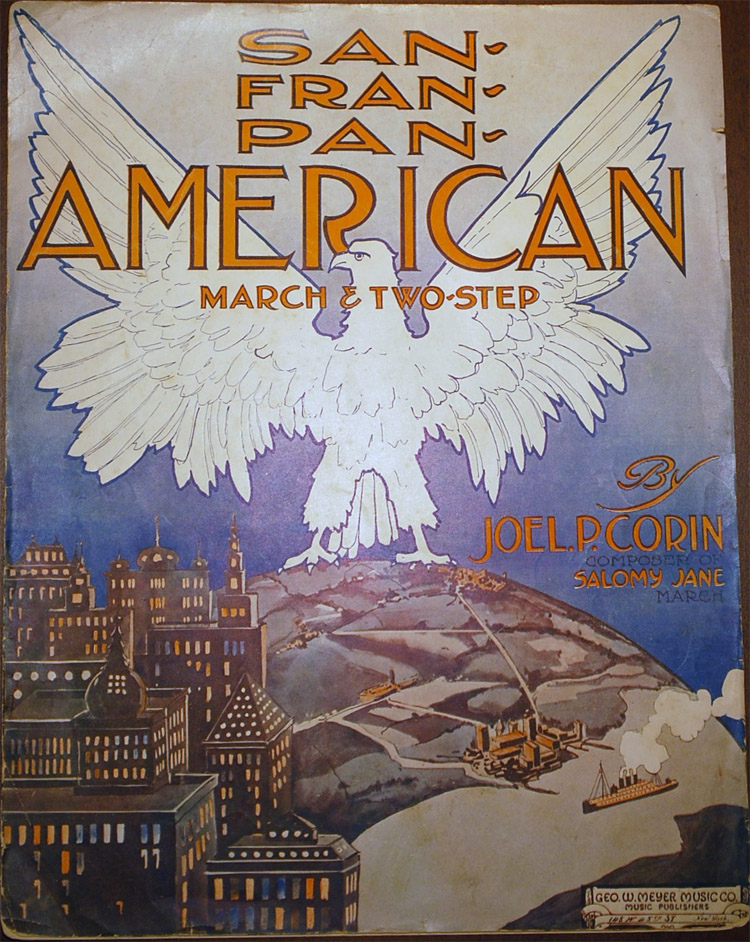
"San-Fran-Pan-American March &
Two-Step" by Joel P. Corin, Geo. W. Meyer music Co., New York,
1915 (Courtesy Jamieson Collection, JC-SFP).
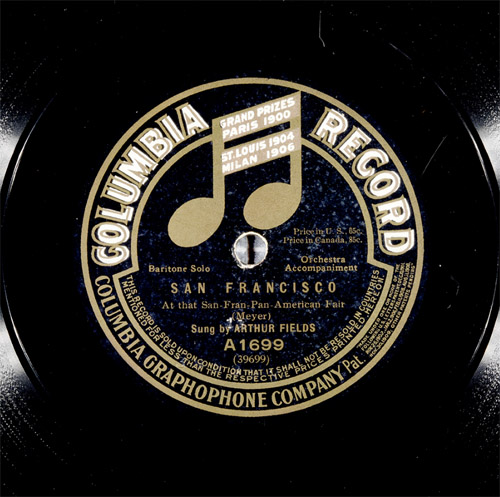
LISTEN
to "San Francisco (At that San-Fran-Pan-American Fair" sung
by Arthur Fields, Columbia Record No. A1699, Recorded January 26,
1915 (Courtesy of David Giovannoni Collection).
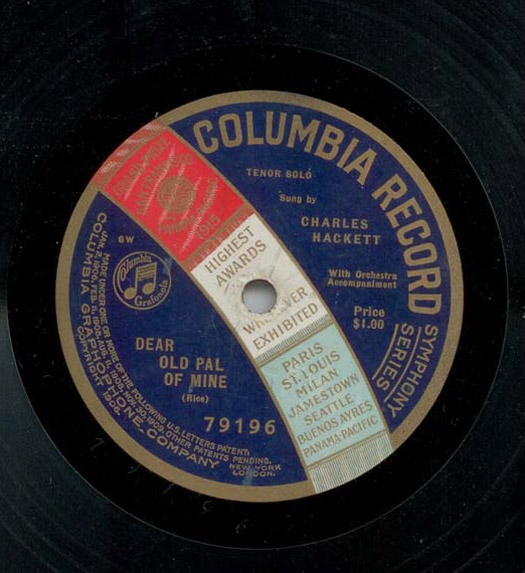
LISTEN
to "Dear Old Pal of Mine" (Rice) Sung by Charles Hackett,
Columbia Record No. 79196, Recorded June 17, 1920 (DAHR). The label
is an example of how Columbia Records leveraged an award at PPIE (not
for this recorrd) but for "Highest Awards" at Panama-Pacific
Exhibition. Recording courtesy of Internet Archive.
(Record Label courtesy
Jamieson Collection, JC-RSS).
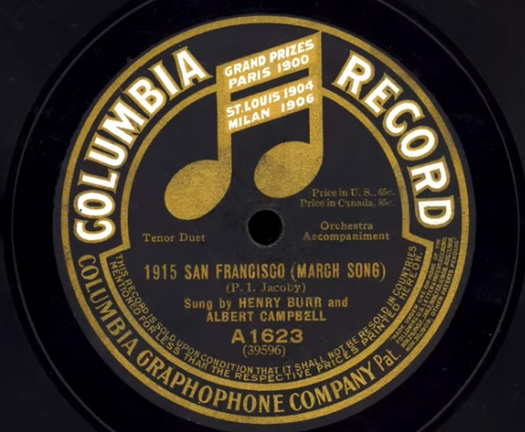
LISTEN
to "1915 San Francisco (March Song)" Sung by Henry Burr
and Albert Campbell, Record No. A1623 Recorded Oct 27, 1914 New York
(Courtesy DAHR)

WATCH
1915 San Francisco March sung by Henry Burr and Albert Campbell,
Columbia Record 1914 - YouTube video created by abendstunde49 (2013).
WATCH PBS AMERICAN EXPERIENCE
"The
Panama Canal."
- The Trailer :30 (Courtesy of PBS)
On August 15, 1914, the Panama
Canal opened connecting the world's two largest oceans and signaling
America's emergence as a global superpower. The story of the canal
features a cast of colorful characters ranging from an indomitable
president to visionary engineers to tens of thousands of workers
from around the world, rigidly segregated by race.
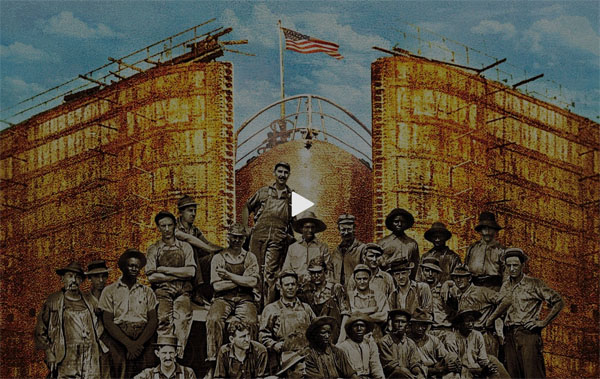
Edison Films made for New York State's
PPIE Exhibition

"The Kinetogram,"
February 1915, p. 5 (The
HathiTrust)
Special thanks to Allen
Koenigsberg, David Giovannoni, the Bancroft Library, the Lester Levy
Sheet Music Collection, the University of California-Davis, the Internet
Archive, The HathiTrust, Library of Congress, Rod Pickett and John
Jamieson.
See The
Jamieson Collection for more examples of PPIE ephemera and collectibles
including sheet music and records.
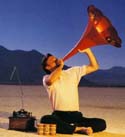
Phonographia






